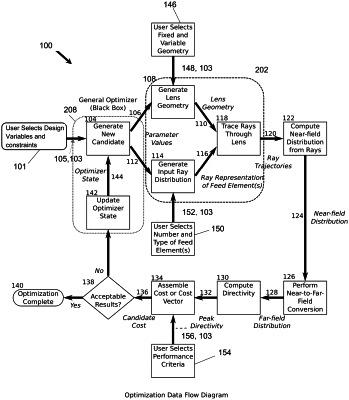| CPC H01Q 15/02 (2013.01) [G06F 30/20 (2020.01); H01Q 1/288 (2013.01); H01Q 1/48 (2013.01); H01Q 15/08 (2013.01); H01Q 19/062 (2013.01); H01Q 25/008 (2013.01)] | 20 Claims |

|
1. A system, comprising:
one or more processors;
and memory including instructions that, when executed by the one or more processors, cause the system to:
receive one or more lens antenna design constraints, the one or more lens antenna design constraints requiring, at least in part, a plurality of laminar layers of discrete material types, wherein a refractive index of the plurality of laminar layers increases in non-uniform increments from an outermost layer of the plurality of laminar layers to an innermost layer of the plurality of laminar layers, and the one or more lens antenna design constraints that are received constrain a magnitude of a gradient of a refractive index profile, wherein the magnitude of the gradient indicates a rate of change of the refractive index;
generate a current candidate lens antenna based on the lens antenna design constraints and prior candidate lens antenna cost vectors, the current candidate lens antenna having a dielectric constant profile defined with a polynomial in an r-axis and a z-axis;
generate a plurality of rays for the current candidate lens antenna based on the one or more lens antenna design constraints;
compute a near-field distribution based on the rays generated for the current candidate lens antenna;
compute a far-field distribution based on the near-field distribution;
compute a current cost vector based on the far-field distribution and the near-field distribution for the current candidate lens antenna to maximize aperture efficiency;
determine if the current cost vector is compliant with the lens antenna design constraints;
provide the current cost vector as the prior candidate lens antenna cost vector to determine the current candidate lens antenna until the current cost vector is compliant with the lens antenna design constraints if the current cost vector is not compliant with the lens antenna design constraints;
and set the current candidate lens antenna as the selected lens antenna if the current cost vector is compliant with the lens antenna design constraints.
|